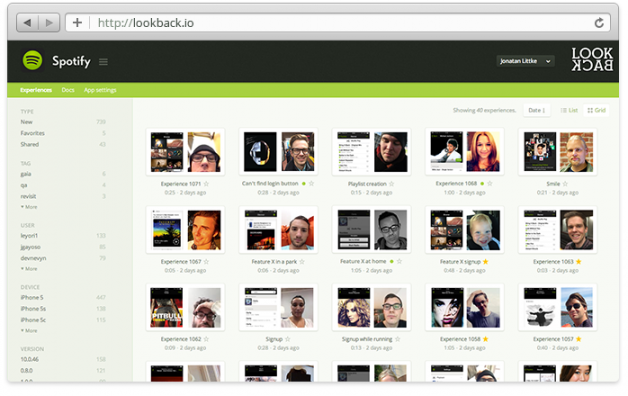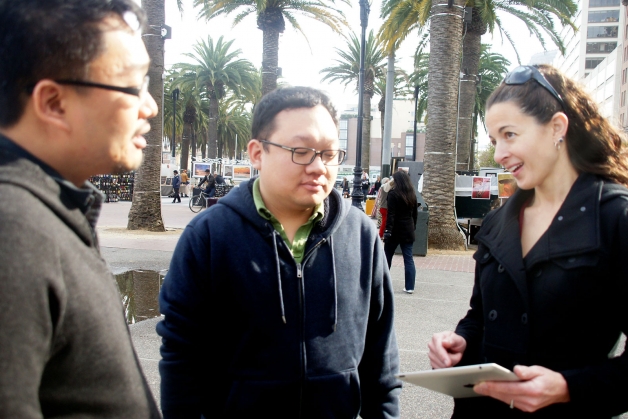As experience design practitioners, we spend our waking lives concocting products and services that are rewarding and easy to use. We spend plenty of time thinking about “the user,” but what about us? We’re users, too.
For UX practitioners, the roads leading through product design and development are often fraught with frustrating and/or ill conceived experiences. One place this is especially evident is in usability testing software. To remedy this situation, the forward-thinking design team at Lookback, winner of the Design for Experience award in the Innovative Technique or Tool category, built their user experience management platform from the idea that “we’re all consumers.”
A mobile app screen recorder for user testing, Lookback takes this kind of activity to new heights, allowing developers to record not only a user’s actions on-screen but also their face and voice using the device’s camera and microphone. Moving past the clunky external recording devices that are known for disrupting the natural actions of users and frustrating folks on both sides of the testing game, Lookback marks impressive innovation. But beyond rethinking the way companies test their mobile products, the goal was also to create a tool for enterprise use that had the user experience of a consumer product.
A mobile app screen recorder for user testing, @Lookback takes this kind of activity to new heights
“People have been spoiled on a personal level with great experiences,” says CEO and Co-Founder Jonatan Littke. “They are less willing to adopt standard corporate software at their workplace when they have a [vastly] better solution at home. I think this is why companies like Dropbox and Evernote grow their business offerings through individuals who couldn’t be bothered with the company’s way of doing things, and signed up for something themselves, which then spreads as more and more individuals join in.”
There has been a dramatic shift in enterprise products lately, with substantial efforts going into making sure these pieces of sophisticated software are meeting their users in a familiar place. The way that Lookback is extending those efforts to improve such experiences specifically for UX practitioners is good news for our community.
“It turns out research software hasn’t been given a whole lot of love and people are so hungry for lots of things,” Littke says. “We’re getting new feature requests daily. Currently, we’re focusing on improving the recording experience and expanding to more platforms, while improving quality and stability of our current product.”
Lookback is still in an open beta period, and Littke notes that one powerful benefit of working intimately with experience design professionals is that they provide a useful a list of feature requests because they know how to articulate their needs.
“The old ‘don’t ask your customers what they want’ certainly has not been true for us. On the contrary, it’s given us a lot of value,” he says. “I remember a research meeting with the SoundCloud mobile team where they gave us a roadmap for the next nine months of what we should work with, and it pretty much exactly mirrored the roadmap we had in mind internally.”
Another frustrating thing for practitioners is a whole bunch of data broken up and locked away in silos. No stranger to vast amounts of user data, MailChimp, a finalist in the category, wanted to connect their data streams to an easy-to-use UI so that separate teams might synthesize specific projects to company-wide knowledge. The team turned to Evernote, building on a tool with developed capabilities to suit their needs.
“We’re able to funnel information both passively (nightly scripts of aggregate analytics and application metrics) and actively (original reports, interview transcripts, and usability test results), all via email,” says Gregg Bernstein, Manager of Customer Research. “Email is the key for success—sending emails is part and parcel of the normal workday. By eliminating a separate workflow—the need to visit a site, log in, navigate to the right place, and share data—we’ve reduced friction and made sharing easy.”
Still another trying moment for researchers is attempting to communicate insights gained during field research to remotestakeholders. Finalist Nick Cawthon of Gauge Design in San Francisco found a solution by arming arming his survey team with tablets that could relay responses to survey questions back to stakeholders in Canada in real-time.
Commissioned by Simon Fraser University in British Columbia, and backed by the Canadian Department of Agriculture, the study was designed to see if a controlled but more efficient method of oyster farming would be acceptable to the general public. Gauge Design set up shop on the SF waterfront in proximity to several oyster bars and seafood restaurants that catered to tourists and locals.
“With the client being remote, this feeling of both connection and control became an important part of the overall engagement,” Cawthon says, “providing them with an experience of instant feedback and fulfillment, which would have been impossible using traditional user research methods.”
However you’re gathering data for you design projects, it might be worth stopping to ask if there’s an aspect of your research that might be improved with a little bit of experience design—conducting a little research into your own research, if you will.
“It’s a standing joke at Lookback that we’re researching the researchers, which quickly turns meta,” Littke says. “Someone should build a tool to research how people use Lookback—something we actually can’t do with our own product … yet.”
The 2014 DfE awards are now accepting applications. If you’ve been a part of creating an experience that makes a difference, apply today! If you know of any products or services that deserve DfE recognition, make a recommendation now using the form in the right-hand sidebar (or at the bottom of the page if you’re on a mobile device. For a limited time, anyone who makes a valid recommendation will get a free book download form our sponsor, Rosenfeld Media.
Image of mobile device courtesy Shutterstock.









